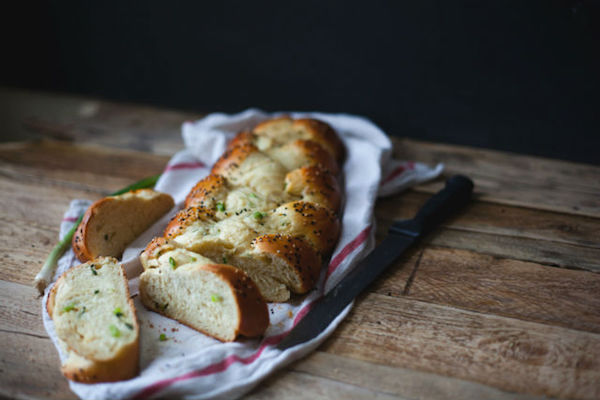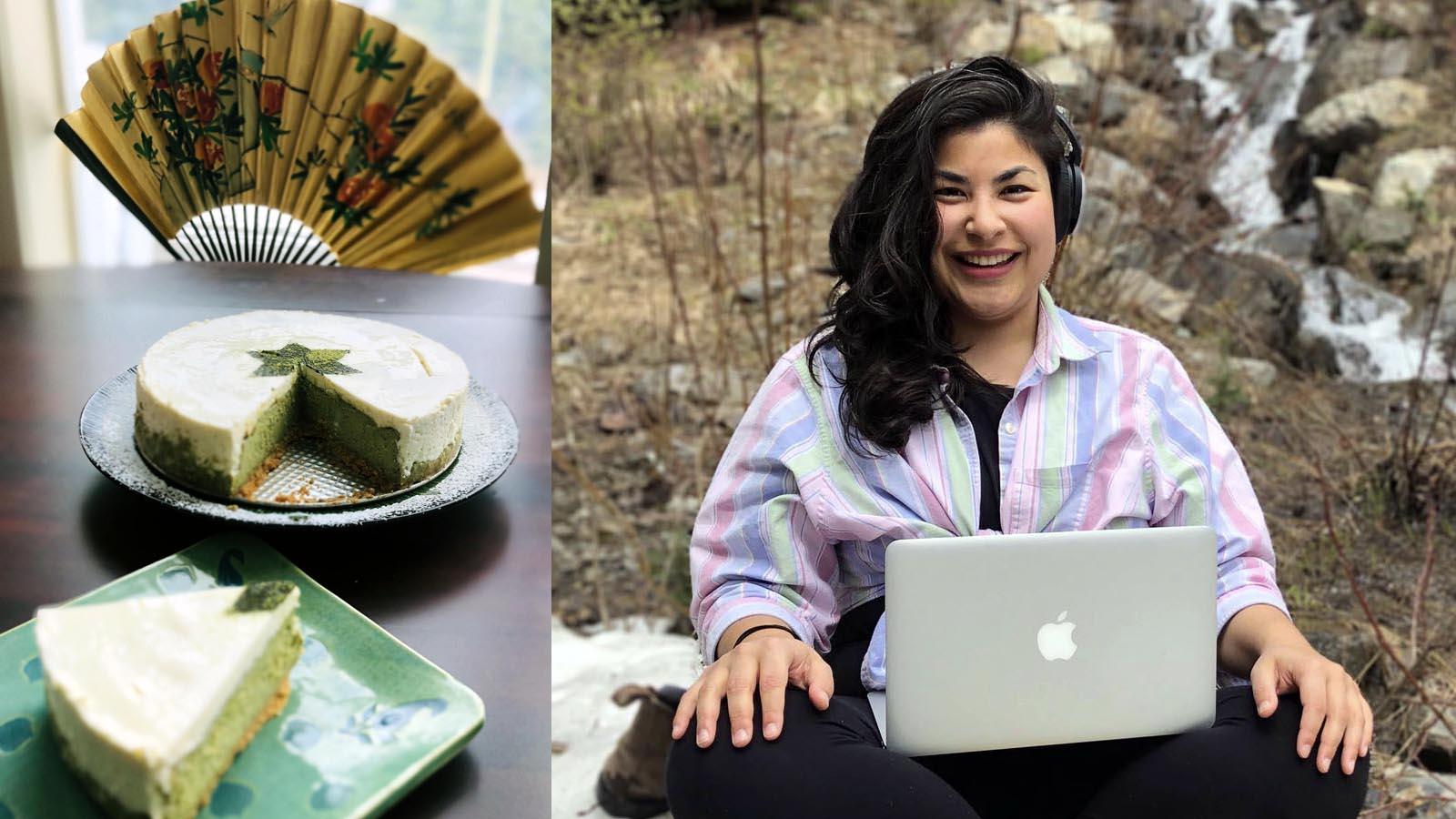 Lauren Monaco Grossman is an artist and cook who brings her talents to bear as expressions of her identity on her website Minty’s Table. Her challah postcards would make the perfect Rosh Hashanah hostess gift or share her greeting cards as you send wishes for a good New Year to friends and family. We were so inspired by her art that we asked her to share her recipe for Challah for the New Year.
Lauren Monaco Grossman is an artist and cook who brings her talents to bear as expressions of her identity on her website Minty’s Table. Her challah postcards would make the perfect Rosh Hashanah hostess gift or share her greeting cards as you send wishes for a good New Year to friends and family. We were so inspired by her art that we asked her to share her recipe for Challah for the New Year.
This challah recipe incorporates tangzhong into the dough, which is a technique used in many of the soft and fluffy breads found across Asia, from steamed baos to shokupan to kopitiam buns. Tangzhong is made by heating flour and water together, cooking it into a slurry, and then adding it to the main dough (similar to yudane). This addition adds moisture and elasticity into the dough, which makes for a softer, fluffier texture after baking.
The tangzhong portion of this recipe is from Lan Lam’s Cook’s Illustrated recipe. I make the tangzhong earlier in the day so it cools before adding it to the rest of the ingredients. It can even be made a few days ahead and stored in the fridge. I like to take my time making challah, allowing the dough to take as long as it needs to do a full rise. This often means I can’t cram it all in one day depending on my schedule. I’ll make the dough on a Thursday, then let it rise overnight in the fridge (you can keep it in the fridge for 2 days). The cold temperature of the dough makes it easier to work with when shaping and braiding.
I’ve incorporated a few other personal preferences in this recipe, but adjust the method to what works best for you. The Cook’s Illustrated recipe uses a higher ratio of egg yolks to whites, but I often just use 4 whole eggs depending on how full my fridge is that week! I also like to nest the baking sheet on top of a second baking sheet for a double pan, which keeps the bottom from overcooking and browning too quickly before the challah is done baking.
This recipe is for kneading by hand, but you can use a mixer if it can handle large amounts of dough.
Challah with Tangzhong
Tangzhong portion adapted from:
https://www.cooksillustrated.com/recipes/11531-easy-braid-challah
Makes 2 loaves
Tangzhong
1 cup water
6 tablespoons bread flour (47 grams)
Dough
4 whole eggs (or 2 large eggs plus 4 large yolks)
1/2 cup water
4 tbsp veg oil
5 1/2 cups bread flour (857 grams)
2 1/2 tsp instant or rapid rise yeast or active dry (1 packet)
1/2 cup sugar
2 tsp salt
Vegetable oil
Egg wash
1 small egg
Pinch of salt
Toppings (optional)
Sesame seeds, poppy seeds, flaky sea salt, or cinnamon sugar
Make the tangzhong:
In a microwave-safe bowl (or on a stovetop), whisk 1 cup of water and 47 grams (6 tbsp) of bread flour until smooth. Microwave for 20 seconds, then stir with a whisk. Continue to microwave in 20-second intervals until the mixture thickens to form a smooth pudding-like consistency that loosely keeps its shape when whisk is lifted from the bowl. This could take anywhere from 40 seconds to 2 minutes. Let cool. The tangzhong can be made ahead of time and stored in the fridge.
Make the dough:
In a large bowl, stir together the cooled tangzhong, eggs (and yolks if using), 1/2 cup water, and oil until well combined. Add the flour and yeast. Mix and knead together until all flour is moistened, 3 to 4 minutes. Let rest for 20 minutes. (This resting period builds a sturdy and stretchy gluten network that makes the dough easier to handle.)
Add sugar and salt and knead dough for about 9 minutes. The dough is ready when you can stretch a small piece and see light through the dough without breaking it. The dough should be dry and firm to the touch.
Lightly oil a large bowl. Form dough into a ball, then places it in the oiled bowl. Turn to coat the dough with oil and then cover the bowl. At this point, I like to let the dough rest in the fridge overnight (up to 2 days) wrapped tightly in a large plastic bag. On baking day, let it sit on the counter for an hour or two before shaping. Or, if baking the same day, let the dough rise at room temperature until it doubles in volume, about 1 ½ – 3 hours. Ideally, it is best to let the dough take its time to expand to the top of the bowl.
Line two baking sheets with parchment paper and nest both sheets on top of another baking sheet. Double panning the baking sheets keeps the bottom from browning too fast in the oven.
Braid the dough:
Transfer dough to the counter and divide in two. Take the first half of dough and cut into equal portions, depending on how many strands you want to braid. For this recipe, I am doing a 5 strand braid, so I will separate each half into 5 sections.
I find that flattening dough for each strand into a rectangle and then rolling the dough up on itself lengthwise makes the loaf bake more evenly and fluffy. To do this, press each portion of dough with your hands into a rough rectangle shape, about 2×9 inches. (You can add fillings to the long side, pressing it into the dough, and repeating the motion all the way up to the opposite edge until a log is formed. Roll log on counter into a 16” rope, tapering the ends of the rope as you roll. Repeat with remaining dough.
 Braid ropes. (Braiding diagrams can be found here: https://laurenmonaco.com/MintysTable-Challah-Diagrams
Braid ropes. (Braiding diagrams can be found here: https://laurenmonaco.com/MintysTable-Challah-Diagrams
For a 5 strand challah, pinch ropes together at one end. Cross strand 2 over strand 3. Then cross strand 5 over strand 2. Then cross strand 1 over strand 3. Repeat until you reach the end of the rope, then pinch and tuck ends under the loaf. (Try not to braid too tight – this can cause the loaf to have an uneven shape.)
Carefully transfer braid to prepared sheets. Repeat with other half of dough.
Make the egg wash:
Shake egg and a pinch of salt in a glass jar for about 10 seconds. This will make a thin fluid egg wash that is easier to coat the bread.
Brush egg wash onto both loaves and loosely cover with a large plastic bag. Let rise until the dough does not spring back fully when gently pressed (this can take anywhere from 1 ½ – 3 hours).
Bake the challah:
Preheat oven to 350 degrees. Adjust oven rack to middle position. Brush loaves with a second coat of egg wash and sprinkle with the topping of your choice. Bake until the challahs are golden brown (interior bread temperature should be 195 degrees F), 30 to 40 minutes. Let cool on baking sheets for 20 minutes, then move to a wire rack and let cool completely.








